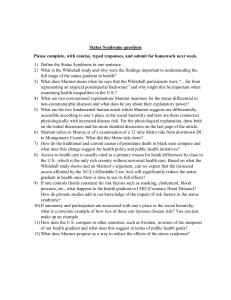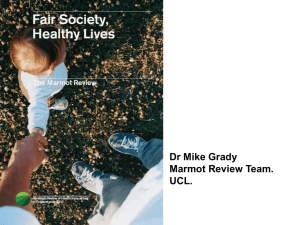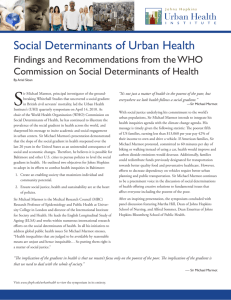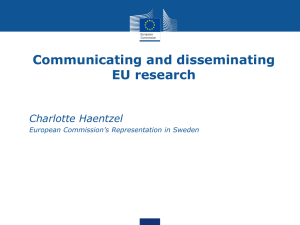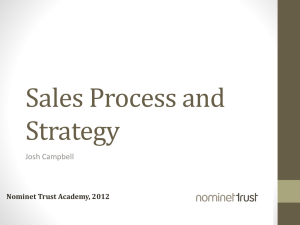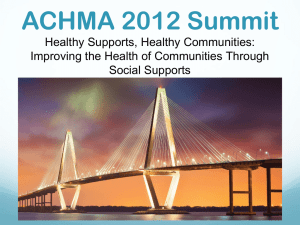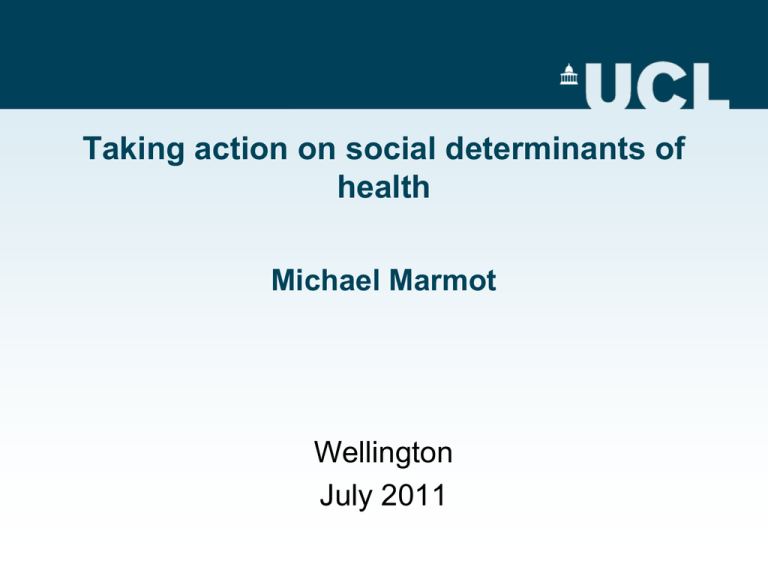
Taking action on social determinants of
health
Michael Marmot
Wellington
July 2011
Inequalities between countries
Glasgow men(Lenzie) 82
Glasgow men (Calton)
54
National data WHO 2009, Glasgow data: Hanlon et al. 2006
*
Trends in life expectancy at birth:
Zambia, Viet Nam, Costa Rica, Sri Lanka
(1950 – 2005, both sexes)
UN data
• Social justice
• Material, psychosocial,
political empowerment
• Creating the conditions for
people to have control of
their lives
www.who.int/social_determinants
• Translating the CSDH recommendations into
different country/regional contexts
•
United Nations, ECOSOC meeting
July 2009
• “…Yet, inequities in health outcomes persist
within and among countries. Most of the
difference is attributable to the conditions in
which people are born, grow, live, work and
age.”
Review of the
Social
Determinants
of Health and
the Health
Divide in the
WHO
European
Region
The CSDH – closing the
gap in a generation
The Marmot Review – Fair
Society Healthy Lives
•A Fair Society
Life expectancy and disability-free life expectancy at birth
by neighbourhood income deprivation, 1999-2003
Social determinants of health across the lifecourse
Fair Society: Healthy Lives:
6 Policy Objectives
A. Give every child the best start in life
B. Enable all children, young people and adults to
maximise their capabilities and have control over
their lives
C. Create fair employment and good work for all
D. Ensure healthy standard of living for all
E. Create and develop healthy and sustainable places
and communities
F. Strengthen the role and impact of ill health
prevention
Marmot Review: 6 Policy Objectives
A. Give every child the best start in life
B. Enable all children, young people and adults to
maximise their capabilities and have control over
their lives
C. Create fair employment and good work for all
D. Ensure healthy standard of living for all
E. Create and develop healthy and sustainable places
and communities
F. Strengthen the role and impact of ill health
prevention
Inequality in early cognitive development of children in the
1970 British Cohort Study, ages 22 months to 10 years
Feinstein 2003
Links between socioeconomic status and factors
affecting child development, 2003-4
Source: Department for Children, Schools and Families
Socio-emotional difficulties at age 3 and 5:
Millennium Cohort Study
Age 3
Age 5
Fully adjusted = for parenting activities and psychosocial markers
Kelly et al, 2010
Per cent achieving ‘a good level of
development’* by deprivation decile: England
*in personal, social and emotional development
and communication, language and literacy at age 5
Source: Department for Education
Per cent 5 year olds achieving ‘good development
score’,* Birmingham LA, West Midlands & England
%
*in personal, social and emotional development
and communication, language and literacy
Marmot Review: 6 Policy Objectives
A. Give every child the best start in life
B. Enable all children, young people and adults to
maximise their capabilities and have control over
their lives
C. Create fair employment and good work for all
D. Ensure healthy standard of living for all
E. Create and develop healthy and sustainable places
and communities
F. Strengthen the role and impact of ill health
prevention
Percentage of pupils achieving 5+ A*–C grades inc English
and Maths at GCSE by income deprivation of area of
residence, England, 2008/9
Marmot Review: 6 Policy Objectives
A. Give every child the best start in life
B. Enable all children, young people and adults to
maximise their capabilities and have control over
their lives
C. Create fair employment and good work for all
D. Ensure healthy standard of living for all
E. Create and develop healthy and sustainable places
and communities
F. Strengthen the role and impact of ill health
prevention
Seasonally adjusted trends in unemployment for young
people in the UK, 1993-2011
37.7%
16-17
18.3%
18-24
8%
16 and over
Source: Office for National Statistics, Labour Force Survey
Population attributable Risk
(PAR) for all combined*
46% 95% CI 37%-53%
adjusted for other
predictors
34% 95% CI 24%-43%
ERI= Effort reward imbalance
*calculated from odds ratios adjusted for age, sex, employment grade
J Head et al,2007
Fair Society: Healthy Lives:
6 Policy Objectives
A. Give every child the best start in life
B. Enable all children, young people and adults to
maximise their capabilities and have control over
their lives
C. Create fair employment and good work for all
D. Ensure healthy standard of living for all
E. Create and develop healthy and sustainable places
and communities
F. Strengthen the role and impact of ill health
prevention
Minimum Income Standard by family type as a
percentage of median income, April 2008
Poor Prospects for living standards
• 12% addition to price level over next 4 years
– Rise in import prices (commodities including foodstuffs,
base metals and cotton)
– Rise in energy prices
– Rise VAT
“in 2011 real wages are likely to be no higher than
they were in 2005. One has to go back to the
1920s to find a time when real wages fell over a
period of six years”
Source: Speech given by
Mervyn King, Governor of the Bank of England
At the Civic Centre, Newcastle
25 January 2011

